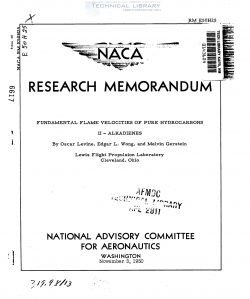naca-rm-e50h25
- Version
- 79 Downloads
- 428.99 KB File Size
- 1 File Count
- April 24, 2017 Create Date
- April 24, 2017 Last Updated
National Advisory Committee for Aeronautics, Research Memorandum - Fundamental Flame Velocities of Pure Hydrocarbons - II - Alkadienes

Data are presented for the fundamental flame velocities of 10 pure
alkadienes that have isolated, conjugated, or cumulative double-bond
systems. On the basis of this limited amount of data and the flame
velocities previously reported, it is concluded that unsaturation
changes the flame velocity in the order alkanes < alkenes < alkadienes
with isolated double bonds 5 alkadienes with conjugated double
bonds < alkadienes with cumulative double bonds E alkynes. There
were no significant differences in the flame velocities of c_is_ and
trans 1,5-pentadiene. The alkadienes,1,2-pentadiene and 2,5-pentadiene,
with different positions of the cumulative double bond in the straight
chain, have similar flame velocities. Methyl substitution in a hydro-
carbon reduces the flame velocity; the extent of the reduction
increases with the degree of unsaturation of the hydrocarbon.
Reference 1 presented fundamental flame-velocity data, obtained
by a tube method, for 57 hydrocarbons including normal and branched
alkanes, alkenes, and. alkynes; aawell as cyclohemane and. benzene. It
was concluded that unsaturation changes the flame velocity in the
order: alkanes < alkenes < alkynes, and that branching reduces the
flame velocity.
This report extends the self-consistent set of fundamental
flame—velocity measurements reported in reference 1 with a series of
alkadienes for use in correlations with flame-propagation theories
and combustor-performance. results.
The experimental technique is the same as that described in refere
ence l. A gaseous combustible mixture of pure hydrocarbon and dried
air of known composition was prepared and introduced into an evacuated,
pyrex, horizontal, cylindrical flame tube with an inside diameter of
25 millimeters and a length of 57 centimeters. An orifice, 8 milli-
meters in diameter, was placed at the ignition and of the flame tube.
A second orifice, 1.7 millimeters in diameter, was inserted at the
opposite end of the tube. A small methyl alcohol flame was the source
of ignition.
| File | Action |
|---|---|
| naca-rm-e50h25 Fundamental Flame Velocities of Pure Hydrocarbons - II - Alkadienes.pdf | Download |

Comment On This Post